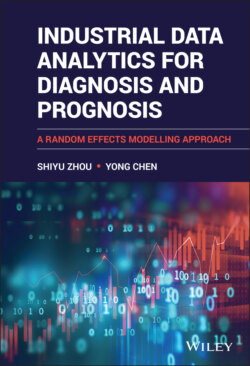Читать книгу Industrial Data Analytics for Diagnosis and Prognosis - Yong Chen - Страница 12
1.2 Scope and Organization of the Book
ОглавлениеThis book focuses on industrial data analytics methods for system diagnosis and prognosis with an emphasis on random effects in the system. Diagnosis concerns identification of the root cause of a failure or an abnormal working condition. In the context of random effects, the goal of diagnosis is to identify the variation sources in the system. Prognosis concerns using data to predict what will happen in the future. Regarding random effects, prognosis focuses on addressing unit-to-unit variation and making degradation/failure predictions for each individual unit considering the unique characteristic of the unit.
The book contains two main parts:
1 Statistical Methods and Foundation for Industrial Data AnalyticsThis part covers general statistical concepts, methods, and theory useful for describing and modelling the variation, the fixed effects, and the random effects for both univariate and multivariate data. This part provides necessary background for later chapters in part II. In part I, Chapter 2 introduces the basic statistical methods for visualizing and describing data variation. Chapter 3 introduces the concept of random vectors and multivariate normal distribution. Basic concepts in statistical modeling and inference will also be introduced. Chapter 4 focuses on the principal component analysis (PCA) method. PCA is a powerful method to expose and describe the variations in multivariate data. PCA has broad applications in variation source identification. Chapter 5 focuses on linear regression models, which are useful in modeling the fixed effects in a dataset. Statistical inference in linear regression including parameter estimation and hypothesis testing approaches will be discussed. Chapter 6 focuses on the basic theory of the linear mixed effects model, which captures both the fixed effects and the random effects in the data.
2 Random Effects Approaches for Diagnosis and PrognosisThis part covers the applications of the random effects modeling approach to diagnosis of variation sources and to failure prognosis in industrial processes/systems. Through industrial application examples, we will present variation pattern based variation source identification in Chapter 7. Variation source estimation methods based on the linear mixed effects model will be introduced in Chapter 8. A detailed performance comparison of different methods for practical applications is presented as well. In Chapter 9, the diagnosability issue for the variation source diagnosis problem will be studied. Chapter 10 introduces the mixed effects longitudinal modeling approach for forecasting system degradation and predicting remaining useful life based on the first time hitting probability. Some variations of the basic method such as the method considering mixture prior for unbalanced data in remaining useful life prediction are also presented. Chapter 11 introduces the concept of Gaussian processes as a nonparametric way for the modeling and analysis of multiple longitudinal signals. The application of the multi-output Gaussian process for failure prognosis will be presented as well. Chapter 12 introduces the method for failure prognosis combining the degradation signals and time-to-event data. The advanced joint prognosis model which integrates the survival regression model and the mixed effects regression model is presented.
